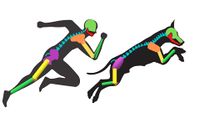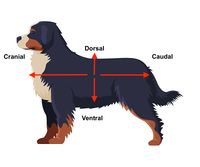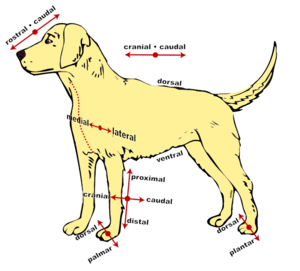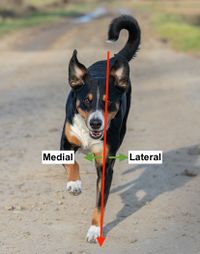Which Bone Is Present In Humans, But Absent In Four-legged Animals?
Terminology [edit | edit source]
Many veterinary anatomical terms are similar to those used in human anatomy, but there are some of import terms to know if you are working with animals.

Animals stand on all fours: [1]
- Anterior in humans = cranial in animals
- Posterior in humans = caudal in animals
- Ventral in humans – towards the front (palm), ventral in animals = directed towards the footing
- Dorsal in humans - towards the back, dorsal in animals = directed towards the spine
For instance the cranial cruciate ligament in dogs is the same equally the "anterior" cruciate ligament (ACL) in humans. The caudal cruciate ligament in dogs is the same as the "posterior" cruciate ligament (PCL) in humans

Animals are quadripedal – i.e. their vertebral column is parallel to the ground:[1]
- Head is cranial
- Tail is caudal
- Within the head, rostral refers to structures closer to the nose
Terminology relevant to the limbs: [i]
- Proximal - the parts of the limbs that are nearest to the torso
- Distal - the part of a structure that is furthest away from the principal mass of tissue
- Forepart limb - the thoracic or pectoral limb
- Hind limb - the pelvic limb
Terminology referring to the thoracic or forelimb: [1]

- Dorsal – cranial face up of the distal part of the forelimb or dorsum of the manus (i.eastward. the section from the carpus downwards)
- Palmar (volar) - opposite to the dorsal surface
- Radial – the part of the forearm where the radius is located (medial)
- Ulnar – the part of the forearm in which the ulna is located (lateral)
- Brachium – specifically the region from the shoulder to the elbow
- Axilla – the infinite between thoracic limb and the thoracic wall
Terminology referring to the pelvic or hind limb: [one]
- Dorsal – anterior face of the distal function of the pelvic limb or dorsum of foot
- Plantar – contrary of the dorsal surface
- Crus – the section of the hindlimb between the knee and the tarsus
- Human foot – the section of the hindlimb from the tarsus down
- Tibial – the side of the leg where the tibia is located (medial)
- Fibular – the side of the leg where the fibula is located (lateral)

This short video will describe more than:
Terminology to bespeak relative distance from the centre of the limb: [1]
- Centrality – the centre line of the body or any part of it
- Axial and abaxial refers to, or being relative to the axis (due east.g. the centric surface of a digit faces the centrality while the abaxial surface faces away from the centrality)
Terminology to indicate the relative distance from the surface of the trunk: [i]
- Superficial – relatively nigh to the surface of the body or the surface of a solid organ
- Deep – relatively well-nigh to the centre of the body or the centre of a solid organ
- External or outer – abroad from the middle of a hollow organ
- Internal or inner – close to or in the direction of the eye of a hollow organ
Terminology to depict the basic movement of the parts of the body: [1]
- Protraction – limb forwards
- Retraction – limb backwards
- Extension – angle increased
- Flexion –bending reduced
Additional Resources [edit | edit source]
References [edit | edit source]
- ↑ ane.0 i.1 1.2 1.3 1.4 1.5 1.vi 1.7 Prydie D, Hewitt I editors.Applied Physiotherapy for Small Animal Practice. Chichester: John Wiley & Sons, Ltd, 2015.
- ↑ atdove.org. Directional Terms in Veterinarian Medicine. 2017. Bachelor from: https://youtu.be/nKYmpzmiwzI
- ↑ Rod Allrich. Directional Terms Used in Animal Anatomy. Available from: https://world wide web.youtube.com/watch?v=T8pCS4rdm38 [concluding accessed 4/1/20201]
Source: https://www.physio-pedia.com/Introduction_to_Quadruped_Anatomical_Terminology
Posted by: franklinhoge1949.blogspot.com

0 Response to "Which Bone Is Present In Humans, But Absent In Four-legged Animals?"
Post a Comment